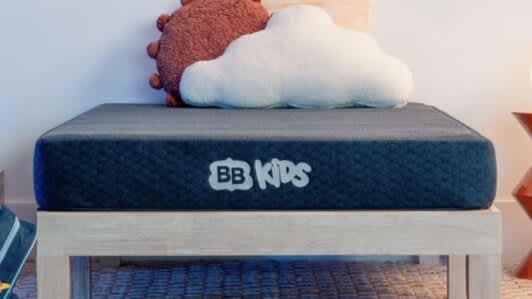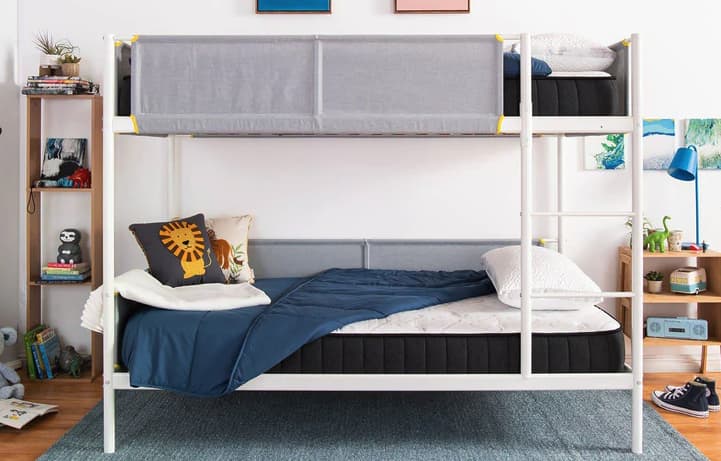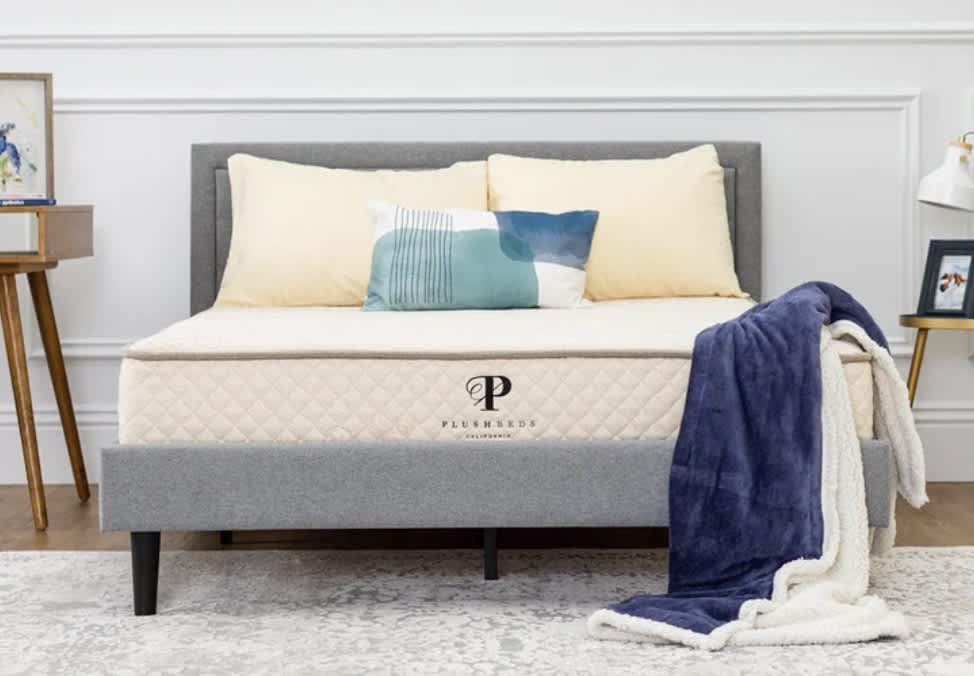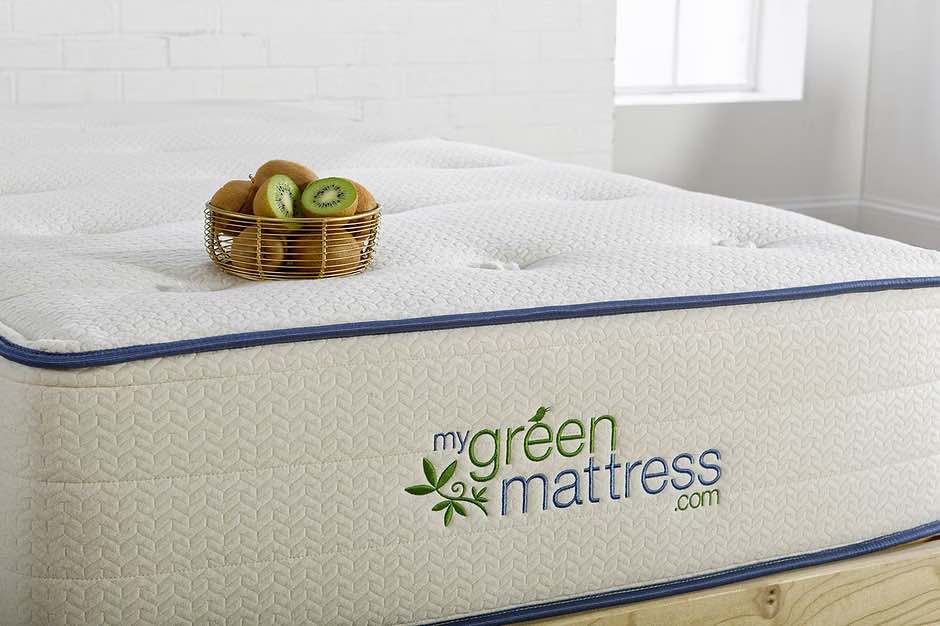On This Page
Best Mattress for Kids
Expert Picks for Every Age
Our Top Picks
-
Best Overall Mattress
Helix Kids -
Best Value Mattress
Brooklyn Bedding Kids Mattress -
Best Mattress for Growing Kids
Bear Cub -
Best Mattress for Pressure Relief
Leesa Kids Mattress -
Best Temperature Regulating Mattress
Nest Bedding Puffin -
Best Mattress for Spinal Alignment
Nolah Nurture Kids -
Best Mattress for Restless Sleepers
PlushBeds Organic Kids Mattress -
Best Organic Mattress
My Green Mattress Kiwi Organic Mattress
Best Overall Mattress

The two-sided Helix Kids is designed for kids between the ages of 3 and 12. One side is firm and offers optimal support for growing children through age 7, while the softer side cradles the body and is best suited to kids 8 and older. A water-repellent cover protects the foam layers from damage when nighttime accidents occur.
Pros & Cons
Pros
- Dual-sided design with each surface intended for different age groups
- Water-repellent cover prevents stains and liquid damage
- Reinforced perimeter coils minimize sinkage when your child gets in and out of bed
Cons
- Foam layers may emit off-gassing odor after the mattress is unboxed
- Not available in a twin XL size
Our Take
Best Value Mattress

The Brooklyn Bedding Kids Mattress is a well-made bed at an approachable sticker price, making it a good option for parents with limited shopping budgets. A 6-inch profile means the mattress is safe and compatible with virtually any bunk bed on the market, while the stain-resistant cover protects the inner layers if your child wets the bed.
Pros & Cons
Pros
- Firm feel helps promote even alignment and proper growth
- Cover is treated to resist stains and liquid damage
- Low-profile design ideal for bunk beds
Cons
- Strong off-gassing odor for the first few nights
- Foam layers may trap heat
Our Take
Best Mattress for Growing Kids

The Bear Cub’s reliable foam-over-coil design is a great choice for toddlers, young children, and preteens. A plush foam surface and strong pocketed coils deliver a nice balance of contouring, support, bounce, and breathability — not to mention the approachable price-point for parents.
Pros & Cons
Pros
- Firm hybrid design promotes even alignment and healthy development
- Stable perimeter helps kids get in and out of bed with ease
- Cover made from cooling Celliant-blend fabric
Cons
- Initial off-gassing odor can be strong and unpleasant
- No waterproof or liquid-blocking components
Our Take
Best Mattress for Pressure Relief

The Leesa Kids Mattress uses plush, adaptive foams to create a soothing sleep surface for your child. This helps ensure they don't feel pressure in sensitive areas during their growing pains phase.
Pros & Cons
Pros
- All-foam design provides gentle cushioning to prevent pressure buildup
- Breathable open-cell layers won't trap too much heat
- Low-profile design is compatible with most bed frames
Cons
- Not available in a twin XL size
- No waterproofing or liquid protection
Our Take
Best Temperature Regulating Mattress

The Nest Bedding Puffin is a firm, supportive all-foam mattress with dense layers to properly support your child and aid their development. The Puffin is approachably priced in all three sizes, and you can add an accident protection plan that covers stains and liquid damage.
Pros & Cons
Pros
- Polyfoam comfort system combines responsiveness and pressure relief
- Phase change material in the cover is designed to regulate temperature
- All-foam construction is virtually noiseless
Cons
- May be too firm for some children
- Relatively short trial period
Our Take
Best Mattress for Spinal Alignment

The reversible Nolah Nurture is designed to support your child through different growth stages. One side feels firm and supportive, making it ideal for most younger kids, while the opposite surface is plusher and best suited to older children.
Pros & Cons
Pros
- Reversible design with a different feel on each side
- Zoned coils provide extra support for the midsection to promote healthy alignment
- Cover is composed of breathable organic cotton
Cons
- Not ideal for older kids who prefer mid-level firmness
- Sticker price is somewhat steep
Our Take
Best Mattress for Restless Sleepers

A lot of kids enjoy bouncy mattresses, and the PlushBeds Organic Kids Mattress delivers a highly responsive surface. This helps your child get in and out of bed with ease and move across the surface without feeling stuck inside their mattress.
Pros & Cons
Pros
- Organic latex core is supportive and bouncy
- Plush wool comfort layer helps the surface stay cool
- Durable latex design holds up well over time
Cons
- Some older kids may prefer a mattress with more contouring
- Not suitable for children with latex allergies
Our Take
Best Organic Mattress

The My Green Mattress Kiwi’s latex hybrid design ensures a responsive, bouncy surface to help kids get in and out of bed with ease. GOLS and GOTS certifications also make the mattress a good option for parents who want to invest in eco-friendly products.
Pros & Cons
Pros
- Latex and wool offer gentle contouring
- Breathable coil system keeps the surface cool
- GOLS and GOTS certifications ensure sustainably sourced materials
Cons
- Thick coil system creates surface vibrations when a sleeper moves
- Priced higher than a typical kids mattress
Our Take
What Do Kids Need for a Good Night’s Sleep?
Choosing a mattress for kids comes with a few different requirements than picking a bed for adults. We’ll look at some useful considerations to keep in mind and then examine each one in depth.
Find the Type of Mattress That Works Best for Your Child
One of the first decisions to make when buying a mattress is whether you prefer a hybrid, innerspring, foam, or latex design. Each has potential advantages and disadvantages for different sleeper types.
Choose the Right Mattress Size and Firmness
When deciding on mattress size and firmness level, parents should consider how the needs of their child may change as they grow. Some mattresses designed for kids feature a flippable construction tailored for multiple age groups.
Price and Lifespan of Your Child’s Mattress
As with any product, you generally pay more for a higher-quality mattress. It might be worthwhile to invest in a higher-end model if you anticipate your child will use the mattress for many years.
Children’s bodies grow every year, which means sleep preferences might change. Shop for a mattress that can accommodate evolving sleep needs, whether it’s a flippable design or a versatile mid-range firmness level.
Is It Time to Buy a New Bed for Your Child?
Well-timed upgrades to your child’s bed are key to their continued comfort as they grow. Here are a few tips on how to know it’s time to replace an old mattress:
- Your child has outgrown their bed: Children need a progressively larger bed as they grow. Your child will need to transition from a crib to a toddler mattress before moving to a bed that provides adequate support for their adolescent and teen years.
- Your child isn’t sleeping well on their current bed: If your child is uncomfortable on their bed or is waking up tired and achy, it may be a sign that their bed isn’t providing the necessary support.
- Their current mattress is old or worn out: Mattresses typically last 7 to 10 years, so be cautious about passing down an old mattress to younger siblings. Signs such as sagging, lumps, and creaking indicate that it’s time for a new bed.
Choosing the Right Mattress Size and Firmness for Your Child
Two of the most important factors to consider when buying a mattress for a child are size and firmness.
How Much Space Does Your Child Need to Sleep?
The sleeping space required for your child depends on their age, size, and personal preferences. Some kids prefer smaller mattresses that feel contained, while others like a larger mattress they can spread out on. After graduating from a toddler bed, we generally recommend anywhere from a twin to a full size mattress.
Twin Mattress
A twin mattress typically measures 38 by 75 inches and is ideal for younger children. It provides ample space for them to move comfortably and change positions while sleeping and is efficient for smaller bedrooms, making it a practical choice for most kids.
Twin XL Mattress
A twin XL mattress, measuring approximately 38 by 80 inches, offers extra length, making it suitable for taller children and adolescents. This extra space helps to accommodate growth spurts, ensuring the mattress remains usable for a longer period of time.
Full Size Mattress
At around 54 by 75 inches, a full size mattress provides more width than smaller sizes. We find this size best for children who move a lot in their sleep or prefer more sleeping space. It’s also a good mattress for adolescents who want a mattress that should last through high school.
How Firm Should Your Child’s Mattress Be?
A child’s mattress should balance firm support with comfortable cushioning. Firmness levels should cater to their growing bodies, ensuring proper spinal alignment and comfortable sleep.
Contouring
Contouring refers to how a mattress conforms to the body’s natural curvature. Soft mattresses contour more deeply, allowing a child’s body to sink into the surface. Firm mattresses are less conforming and maintain their shape under weight. Younger children generally need a firmer mattress with less contouring, while older children often appreciate more softness and cushioning.
Sleep Position
Consider your child’s sleep position when selecting the right mattress firmness. Children who sleep on their side normally require softer surfaces for adequate pressure relief, while stomach and back sleepers may benefit from firmer support to maintain spinal alignment.
Edge Support
Good edge support in a child’s mattress provides stability and safety. It ensures the mattress retains its shape and is important for children who sleep, sit, or play near the edge of the bed.
What Should You Consider in a Mattress for Kids?
When shopping for a kids mattress, consider key qualities like the mattress type, durability, and breathability. It’s also important to think about your budget and any allergies or sensitivities that may affect your choice.
Mattress Type
Most mattresses designed for kids are one of four mattress types, each with their pros and cons.
- Innerspring: Innerspring mattresses feature metal coils with a thin layer of cushioning beneath the cover. These beds are often responsive and affordable, but they typically aren’t as durable as other mattress types.
- Foam: Foam mattresses generally provide excellent contouring and pressure relief. However, they can retain heat and may lack edge support.
- Hybrid: Hybrid mattresses offer a balance of a thick comfort system and coil-based support. They are usually responsive and breathable but can be on the pricier side.
- Latex: Natural latex mattresses generally have a buoyant feel that doesn’t conform as closely as other types of foam. They are often favored by eco-conscious consumers but tend to carry high price tags.
Durability
A durable mattress offers long-term comfort and support, making it a wise investment for growing children. How long a mattress lasts depends on a child’s size and sleep position, as well as the mattress’ materials and construction. For example, latex and high-density foam models typically last longer than innersprings and those made with low-density foams.
Allergies
For children with allergies or sensitivities, look for a mattress that minimizes exposure to potential irritants. This means, for example, avoiding latex models for children sensitive to that material. You can also look for certifications that guarantee the mattress is free of certain harmful chemicals and allergens. Common third-party certifications include:
- Global Organic Textile Standard (GOTS): This certifying body verifies that textiles like cotton and wool meet organic and nontoxic standards.
- Global Organic Latex Standard (GOLS): Specifically for natural latex, this standard confirms the organic status and safety of the material.
- OEKO-TEX Standard 100: This certification ensures that textiles do not contain any of more than 300 potentially harmful chemicals and other substances.
- CertiPUR-US: This foam certification program indicates that foams used in a mattress are free of certain harmful substances, including heavy metals and toxic flame retardants.
Safety was our top consideration when looking for mattresses for our kids, so my wife and I made sure to check for certifications from third party organizations to ensure the materials used in the mattresses were safe for our growing family.
Breathability
Breathability in a mattress is important for children who sleep hot. A breathable mattress effectively regulates temperature and doesn’t allow body heat to build up in the materials. When looking for a breathable mattress, focus on types that allow for ample airflow, like innersprings, hybrids, or perforated latex models.
Price
Children’s mattresses are available in a wide range of price-points, ranging from less than $100 for a basic foam model to over $1,000 for a luxury model with added features. Factors influencing the price include mattress size, material quality, and brand reputation.
Tips to Get the Most Out of a Mattress for Your Child
We know that a new mattress can be a big investment, so we’ve compiled several tips to help you make the most of your purchase.
Think Ahead and Plan for the Future
When selecting a mattress, consider how your child’s needs may evolve over time. For example, a young child may be happy on a twin size mattress, but a twin XL may be a better choice to account for adolescent growth spurts. A mattress that suits both current comfort and future growth can be a smart, long-lasting choice.
Use a Waterproof Mattress Protector
To extend the lifespan of your child’s mattress, consider buying several mattress protectors that can be swapped out when one is soiled. This can help if you’re managing bedwetting or trying to resist stains. Also, be sure to clean the mattress according to the manufacturer’s instructions and rotate or flip it as needed.
Mattresses that are well-maintained are more likely to go the distance. Since kids mattresses are prone to stains and spills, it’s helpful to be prepared when things get messy. Watch our video below for more tips on how to keep your child’s bed clean.
Consider a Mattress Topper or Pad
Young children typically need a firm mattress, while older children and those going through adolescence tend to appreciate more softness. Rather than having to buy a new mattress when a child’s preferences change, mattress toppers and mattress pads can be a quick and easy way to add a touch of plushness to an otherwise firm bed.
Take Advantage of Trials and Warranties
Before making a purchase, check the length of the mattress’ sleep trial and warranty. Sleep trials allow parents and children to test a mattress for a period of time before deciding if it’s a good fit. If the new mattress isn’t right, the brand will arrange a return or exchange.
Warranties cover manufacturer defects like tears and excessive sagging. Leveraging sleep trials and warranties can ensure you’re satisfied with your purchase, especially if you’re shopping for a mattress online.
Discover More Mattress Solutions
If you also need a crib mattress for a newborn or a bigger bed for a teen, check out our guides below. We’ve also included some other niche mattress picks for specific types of sleepers.
More Top Mattress Options for Growing Kids
How We Test
As experts in the sleep industry, our approach to testing children’s mattresses is thorough and informed by data. To come up with our favorites, we evaluated a wide array of mattresses for kids, considering factors like support, breathability, temperature regulation, and reversibility.
Frequently Asked Questions
While it’s essential that babies sleep on a firm mattress in a safety-approved crib, older children can sleep on a firm or soft mattress as long as it feels comfortable and provides the necessary amount of support. The choice between firm and soft depends on the child’s weight, sleeping position, and personal preference.
There’s no single best mattress type for children, as the ideal choice varies based on individual needs and preferences. Hybrid mattresses are often chosen for their combination of support and comfort, while foam mattresses are favored for their contouring and lower price tag. Ultimately, consider factors like support, comfort, and potential allergies when choosing the right type of mattress for your child.
The best mattress size for children varies with age. Toddlers transitioning from a crib can move to a twin or a twin XL, offering ample space for growth. As children grow into teenagers, a full or queen size mattress can provide more room and remain suitable into adulthood.
Kids mattresses are usually 6 to 10 inches tall. While taller mattresses can offer a more luxurious look, lower profiles are often needed for bunk and trundle beds. Additionally, shorter mattresses provide easier accessibility for young children, making it simpler for them to climb in and out of bed.
The best mattress for kids with allergies is typically one containing hypoallergenic materials like natural latex or organic cotton. We also suggest looking for mattresses with certifications like CertiPUR-US, OEKO-TEX, or GOTS to ensure they are free of harmful chemicals.
